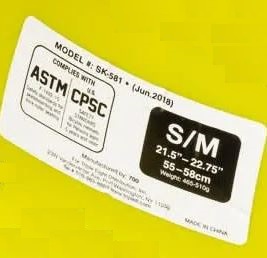Mountain biking can be a fun and exciting sport. But it can also be dangerous if you take a fall. That’s why it’s so important to wear a good helmet when mountain biking. Helmets can help protect your head from injury if you crash. When buying a mountain bike helmet, you’ll notice some have MIPS technology and some don’t. What is MIPS and is it really better than a regular helmet? Let’s take a look!
What is MIPS?
MIPS stands for Multi-Directional Impact Protection System. It is a special layer inside some helmets that helps protect against certain head injuries. Here’s how it works:
When you fall, most helmets are good at absorbing straight-on impacts. But many accidents don’t involve just direct hits. Often your head twists or rotates during a crash. This can cause serious brain injuries.
MIPS adds an extra layer inside the helmet that allows a small amount of rotation. This helps reduce the twisting forces on your head and brain.
Think of your head like an egg. If you hold an egg still and squeeze it, the shell protects the inside. But if you twist the egg, it can damage the inside without cracking the shell. MIPS lets the helmet slide just a little over your head upon impact. This dissipates the twisting forces to help prevent injury.
So in short, MIPS helmets have a special layer that provides additional protection against rotational impacts to your brain. This can help reduce the risk of concussions and other brain injuries during certain crashes.
The Benefits of MIPS Helmets
MIPS helmets have been around for over 20 years. Studies have shown they can provide improved protection compared to regular helmets:
- In lab testing, MIPS helmets reduce rotational forces up to 40% better than non-MIPS helmets. This can help prevent concussions.
- MIPS helmets provide additional protection across a range of impacts and speeds. The MIPS layer works at both high and low speeds.
- MIPS can be beneficial even in impacts without direct rotation. The added layer helps manage energy and motion in all types of crashes.
- Numerous brands have adopted MIPS into their helmet designs. They continue to use MIPS because testing shows it works.
- Many pro cyclists choose MIPS helmets because they feel it gives them better protection.
The bottom line is that MIPS has been proven to help reduce the risk of certain brain injuries. While no helmet can prevent 100% of concussions, choosing MIPS provides an additional level of safety.
Compare MIPS and Standard Helmets
MIPS helmets look very similar to regular helmets, but have some key differences:
- MIPS helmets have an extra layer inside that sits over your head like a loose beanie. This allows the helmet to slide minimally during impact to redirect rotating forces.
- The MIPS layer adds a little bit of weight compared to the same model non-MIPS helmet. The difference is usually 25-50 grams.
- MIPS helmets are often more expensive than non-MIPS versions. The MIPS models typically cost $20-$50 more for the added technology.
- Aside from MIPS, the helmet can have all the same features like ventilation, adjustment system, visor, etc. The outer shell and overall design is often identical.
- Performance should feel about the same when riding. The MIPS layer inside does not affect the fit.
So in summary, MIPS helmets look very similar on the outside but have a special layer inside to handle rotational motion. There is a slight increase in price and weight for the added safety.
When to Choose MIPS
MIPS can provide improved protection against certain injuries. But is it necessary for everyone? Here are some things to consider when deciding on MIPS:
- MIPS is most beneficial for mountain biking and other sports with higher chances of a angled impact. Road biking has fewer obstacles so MIPS may be less important.
- Beginner and less experienced riders may benefit more from MIPS as they are more prone to falls and crashes. Advanced riders crash less often.
- Children and teenagers can especially benefit from MIPS as their brains are still developing. Concussions can be very dangerous for kids.
- MIPS is useful for downhill or park riding where higher speeds and crashes are more likely. For casual trail riding the advantages are less pronounced.
- The rotational forces that MIPS protects against may not occur in all crashes. But it can help in many accidents so added protection is beneficial.
While MIPS technology comes at a small premium, most riders can benefit from the additional safety. If your budget allows, choosing MIPS is generally recommended, especially for newer riders and kids.

Typical MIPS Helmet Features
While the MIPS layer is the key benefit, most MIPS helmets also have great additional features:
- Durable polycarbonate or composite shell to handle direct impacts. This outer layer spreads forces over a wider area.
- Expanded polystyrene or EPS foam liner to absorb energy in a crash. Many impact foams or cones provide progressive cushioning.
- Comfort pads with adjustable fit system to dial in the perfect fit. This ensures optimal protection.
- Integrated visor to shield your eyes from sun, rain, mud and debris. Usually adjustable.
- Vents and channels to allow airflow. Keeps your head cool even on hot rides.
- Light mounts so you can ride safely after dark. Helmet lights enhance visibility.
- Complies with CPSC safety standards for bicycling. Ensure the helmet has proper certification.
- Bright colors and graphics. Allows riders to express their style.
The MIPS layer adds very important protection against rotation. But the rest of the helmet design also plays a key role in safety and performance.

Caring for Your MIPS Helmet
Like any helmet, a MIPS model requires some basic care and maintenance:
- Inspect the helmet before and after each ride. Look for any cracks or damage. Replace the helmet if it shows signs of impact.
- Clean the helmet regularly with mild soap and water. Don’t soak the pads – just use a damp cloth.
- Replace the helmet if it develops any cracks, dents, fraying or tears. Do not attempt repairs.
- Store the helmet in a cool, dry place out of direct sunlight. Don’t leave it in a hot car.
- Replace your helmet every 3-5 years as materials break down over time. The MIPS layer can wear out.
- Follow any specific care instructions from the manufacturer. Some have removable pads.
- Do not paint or apply stickers to the helmet as they can impact safety.
Taking good care of your MIPS helmet ensures you get the full protective benefits over its usable lifespan. Check it before each ride and replace it when needed.
Brands With MIPS Helmets
Many top bike helmet brands now incorporate MIPS into some of their models:
- Bell was the first company to adopt MIPS in their helmets back in 2014. They continue to offer a wide range of MIPS models.
- Bontrager offers MIPS in several of their mountain bike helmets known for great ventilation and comfort.
- Smith has MIPS in their high-end performance helmets like the Forefront used by pros.
- Giro introduced MIPS in their helmets in 2017. It’s now found throughout their line.
- Fox Racing uses MIPS liner technology in their higher-end helmets for trail and downhill.
- Troy Lee Designs, POC and Leatt also offer many helmet models featuring MIPS systems.
Nearly every major cycling helmet manufacturer now recognizes the benefits of MIPS and includes it in their product lines.

The Bottom Line
MIPS helmets provide an additional layer of protection by reducing harmful rotational forces on your brain during crashes:
- MIPS can decrease the risk of concussions and brain injuries across a range of impacts.
- Extensive research and testing has proven MIPS technology is effective.
- The MIPS liner allows a small amount of rotation to redirect energy upon impact.
- MIPS helmets still offer all the standard features like ventilation, visors and adjustability.
- There is a slight increase in price and weight compared to non-MIPS models.
- Most riders can benefit from choosing MIPS especially kids and less experienced cyclists.
While no helmet can prevent all injuries, wearing a helmet with MIPS can significantly improve your safety while mountain biking. For many riders, the added peace of mind is worth the small additional cost.





